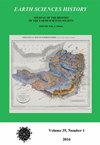THE IMPORTANCE OF THE MUSEUM IN ANTEBELLUM U.S. WESTERN TERRITORIAL EXPLORATION: PART 2. THE ROLES OF HAYDEN AND MEEK IN A PARADIGM SHIFT IN GEOLOGIC AND PALEONTOLOGIC STUDIES
IF 0.6
4区 哲学
Q4 GEOSCIENCES, MULTIDISCIPLINARY
引用次数: 1
Abstract
Established under the antebellum leadership of Joseph Henry and Spencer Baird, the respect given the Smithsonian Institution had far-reaching effects on budding geological careers and the conservation and curation of fossils at national and state levels. Specifically, F. V. Hayden received sufficient perceived encouragement in his geological and natural history endeavors to prevail under no less than hardship conditions. Consequently, Hayden triumphed on his return from the field in 1856, with specimens that would quickly alter his immediate destiny and that of F. B. Meek. The five documents accepted for publication in 1856 by the Academy of Natural Sciences of Philadelphia produced not only a large number of new species, but Hayden’s northern Great Plains stratigraphy and a biostratigraphic/biochronologic catalog of species original to western studies. Others were now also repeatedly citing Hayden with Meek for non-molluscan specimens based on his collections, with new species named in his honor. The nature of western geological exploration changed because of Hayden’s successful employment as geologist and naturalist to the G. K. Warren and W. F. Raynolds Missouri and Yellowstone expeditions. Onsite, ‘fact-based’ mapping with fossils in stratigraphic sections were arguably now required. No more qualified or experienced individual left the western territories as the Civil War commenced. Meek’s deathbed monograph provided a redescription and the first figures of Meek and Hayden 1856 taxa. Although there are reasons suggested herein, a conundrum exists as to why Meek replaced many 1856 ‘types’ with different specimens, sometimes from different localities. The specimens used in the 1856 Meek and Hayden papers were first unpacked for study by Meek and Hayden in Albany. Shipment of fossils from field to museum, however, was not without peril. The presumption is that the specimens accompanied Meek when he moved to Washington in 1858. A National Museum sponsored and implemented program fostered an ever-expanding ‘duplicate’ distribution of specimens to national and international institutions. Henry and Baird were dedicated to this program. Starting in 1861, surplus fossil invertebrates were removed from National Museum holdings. Many thousands of specimens were transferred, with nearly one thousand specimens documented in a single shipment to one institution. How much of the Hayden collection was affected and how many types were redistributed is as of yet unknown. The remaining Hayden collection in the National Museum is pared-down to type and figured specimens. Hayden’s ‘buckets’ of specimens are being, in some cases, slowly virtually repatriated.博物馆在南北战争前美国西部领土勘探中的重要性:第二部分。海登和米克在地质学和古生物学研究范式转变中的作用
史密森学会是在南北战争前约瑟夫·亨利和斯宾塞·贝尔德的领导下建立的,人们对它的尊重对萌芽中的地质学事业以及国家和州一级的化石保护和管理产生了深远的影响。具体来说,海登在地质和自然历史方面的努力得到了足够的鼓励,他在艰苦的条件下取得了胜利。因此,海登在1856年从野外归来时取得了胜利,他的标本很快改变了他和F. B. Meek的命运。1856年费城自然科学院接受出版的五份文件不仅产生了大量的新物种,而且还产生了海登的北部大平原地层学和生物地层学/生物年代学的物种目录,这些物种是西方研究的原始物种。其他人现在也反复引用海登和米克的非软体动物标本,并以他的名字命名新物种。由于海登作为地质学家和博物学家成功地加入了g·k·沃伦和w·f·雷诺兹的密苏里和黄石探险队,西部地质勘探的性质发生了变化。在现场,“基于事实”的地层剖面化石测绘可以说是现在需要的。内战开始时,没有更多有资格或有经验的人离开西部领土。Meek的临终专著提供了Meek和Hayden 1856分类群的重新描述和第一个数字。虽然这里提出了一些原因,但一个难题仍然存在,即为什么Meek用不同的标本替换了许多1856年的“类型”,有时来自不同的地区。1856年米克和海登论文中使用的标本首先由米克和海登在奥尔巴尼拆箱研究。然而,把化石从野外运到博物馆并非没有危险。据推测,这些标本是米克1858年搬到华盛顿时随身携带的。一个由国家博物馆赞助并实施的项目促进了不断扩大的标本“复制”分布到国家和国际机构。亨利和贝尔德致力于这个项目。从1861年开始,多余的无脊椎动物化石从国家博物馆馆藏中移走。成千上万的标本被转移,其中近1000个标本被记录在一次运往一个机构的货物中。海登的藏品中有多少受到了影响,又有多少被重新分配,目前还不得而知。海登在国家博物馆的剩余藏品被削减为打字和图形标本。海登的“一桶桶”标本,在某些情况下,实际上正在慢慢地遣返回国。
本文章由计算机程序翻译,如有差异,请以英文原文为准。
求助全文
约1分钟内获得全文
求助全文
来源期刊

Earth Sciences History
GEOSCIENCES, MULTIDISCIPLINARY-HISTORY & PHILOSOPHY OF SCIENCE
CiteScore
1.00
自引率
0.00%
发文量
1
审稿时长
>12 weeks
期刊介绍:
Earth Sciences History promotes and publishes historical work on all areas of the earth sciences – including geology, geography, geophysics, oceanography, paleontology, meteorology, and climatology.
The journal honors and encourages a variety of approaches to historical study: biography, history of ideas, social history, and histories of institutions, organizations, and techniques.
Articles are peer reviewed.
 求助内容:
求助内容: 应助结果提醒方式:
应助结果提醒方式:


